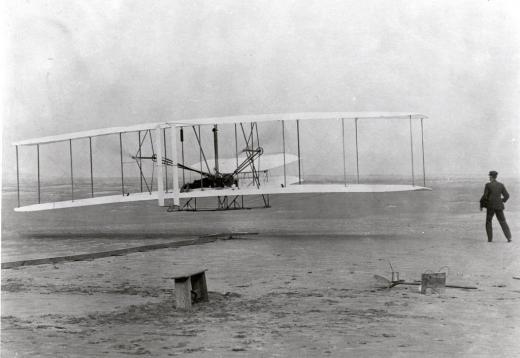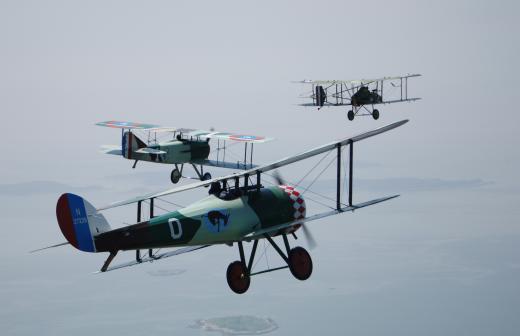What is the Early History of Powered Flight?
 Michael Anissimov
Michael Anissimov
Powered flight is a relatively recent pursuit, with the first controlled heavier-than-air powered flight occurring in Fairfield, Connecticut, by Gustave Whitehead, on 14 August 1901, predating the Wright Brothers’ flight at Kitty Hawk by over two years. Whitehead’s engine-powered plane, with long, hawk-like glider wings, flew over 800 meters at an altitude of 15 meters, according to sworn affadavits signed by 15 attendees of the historic powered flight. Also according to witness reports, (but without sworn affadavits) Whitehead flew over 1 km (over half a mile) in Pittsburgh as early as 1899. This would place the first milestone of heavier-than-air powered flight in the 19th century rather than the 20th. Two modern replicas of Whitehead’s “Number 22” plane have flown successfully.
The better-publicized efforts of the Wright Brothers culminated in the world- famous Kitty Hawk flights at Kill Devil Hills in North Carolina on 17 December 1903. These flights are regarded by the Smithsonian Institution and the Federation Aeronautique Internationale (FAI) as the first sustained, controlled, heavier-than-air manned powered flight, despite the earlier flight by Whitehead, which was not well publicized until the Wright Brothers’ fame was already ensured. In their simply designed Wright Flyer, Orville Wright flew 120 ft (37 m) in 12 seconds in the morning, following up with several more flights, including a fourth flight that covered 852 ft (260 m) in 59 seconds. All the flights were accompanied by an abrupt and unattended “landing,” caused by gusts acting on the early attempt at a flying machine.

Heaver-than-air aviation was all the rage in the first decade of the 20th century, with various inventors making claims, verified or otherwise, of short flights. Lyman Gilmore, for instance, claimed to have successfully flown a plane on 15 May 1902, but there are no witnesses. New Zealand farmer and inventor Richard Pearse supposedly constructed a monoplane aircraft that flew on 31 March, 1903, almost nine months before the Wright brothers flight. In 1904 and 1905, the Wright brothers conducted a further 150 flights at Huffman Prairie in Dayton, Ohio, inviting friends and family to attend. Due to a failed public flight attempt in May 1904, representatives of the media did not attend these later flights.

The history of powered flight experienced a major boost during World War I (1914-1918), when planes were used extensively in war by both the Allies and Central Powers. At first, it was considered ludicrous to use planes for warfare, but they ended up being adopted, first for reconnaissance, but soon for actual assaults.
AS FEATURED ON:
AS FEATURED ON:












Discussion Comments
There was one story in the Bridgeport (Connecticut) Herald in 1901 about Whitehead flying, but that's considered to be fiction, as is the story about him flying in Pittsburgh. Scientific American had articles that talked about Whitehead gliding, but not about flying a powered plane. Those "attendees" wrote those affidavits 30-plus years later. It's a fun story and a good look at how mythology evolves, but it's flat out not true.
Despite the fact of how dangerous it was, pretty much anyone could learn to fly a plane and there were even flying clubs across the country where people would simply fly planes as a hobby!
I am trying to imagine something like this happening nowadays as the technological advances have made it more complex and not as charming, at least in my opinion, to fly a plane.
This was the only time in history in which a complete amateur of any kind could fly a plane if they wanted to and was a time when seeing a plane meant a great deal.
This topic is actually a great subject as a cultural study and I am wondering if there are any television specials or academic based articles or even books that deal with this topic?
I have to say that I have always had a strange obsession with early air travel as I find it to be something that is so impressive, but the means and ways they flew and designed their planes back then were so primitive.
A lot of stories I like come from WWI as early on the pilots did not know how to engage into hand to hand combat while flying planes, so they would usually just pull out a gun and try to shoot each other while flying!
Another thing that was attempted was mounting a machine gun behind the propeller to shoot at the enemy, but the one problem was that a lot of the bullets would hit the propeller and crash the plane, so a pneumatic system had to be created to shoot bullets when the propeller was out of the way.
These types of things I find incredibly interesting and stories of men like the Red Baron as always great stories to read about as early aviation was quite romanticized even though it was in its infancy.
The problem with the story is that there were apparently witnesses that claim it flew for several hundred feet and crashed into a building in Pittsburgh, but there is nothing at all reported on this and the testimony was not sworn.
Also, when the Smithsonian sent someone to investigate the plane, the one Whitehead showed them was deemed to not be possible to fly and they pretty much blew him off as a failed inventor.
Despite all this it got press because several dozen people were competing to become the first to fly and it was only a matter of time before someone finally did it, and the Wright brothers happened to be the first ones.
This in itself was controversial as it sparked off a lot of false claims and Whitehead's claim is the most famous of them all.
I really have to wonder why I have not heard as much about this before, because the invention of flying is considered one of the greatest achievements in human history and to think that history has been wrong for all these years is something to really take in.
I have to wonder if this is a case of mis-reporting in the media or if it is a simply case of something new coming to light or if it is something that is not substantiated by enough witnesses to make a legitimate claim?
Post your comments